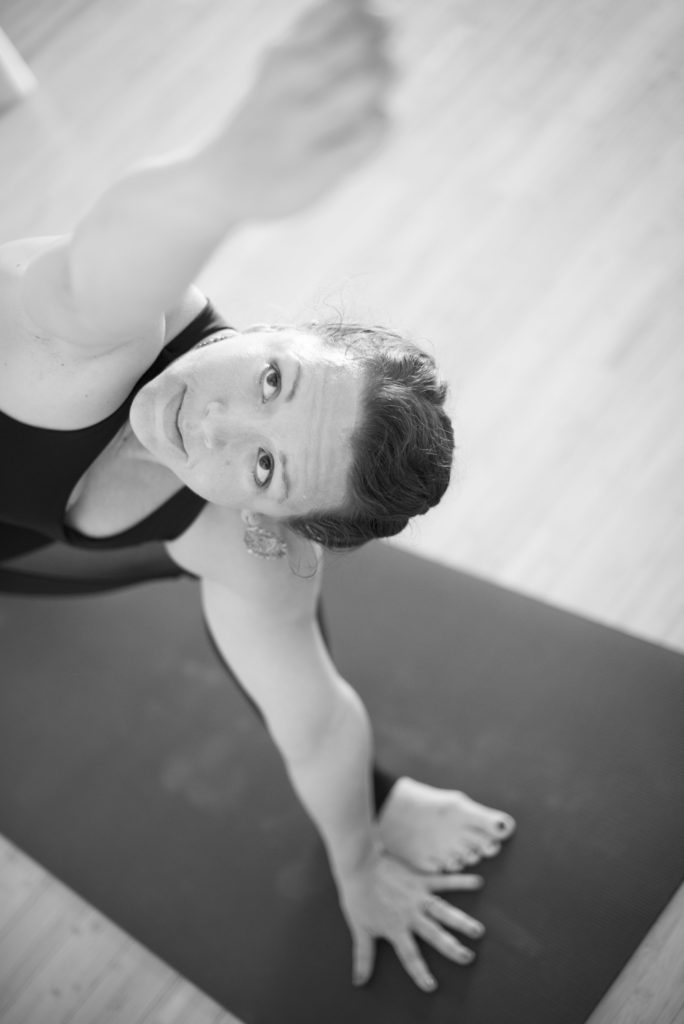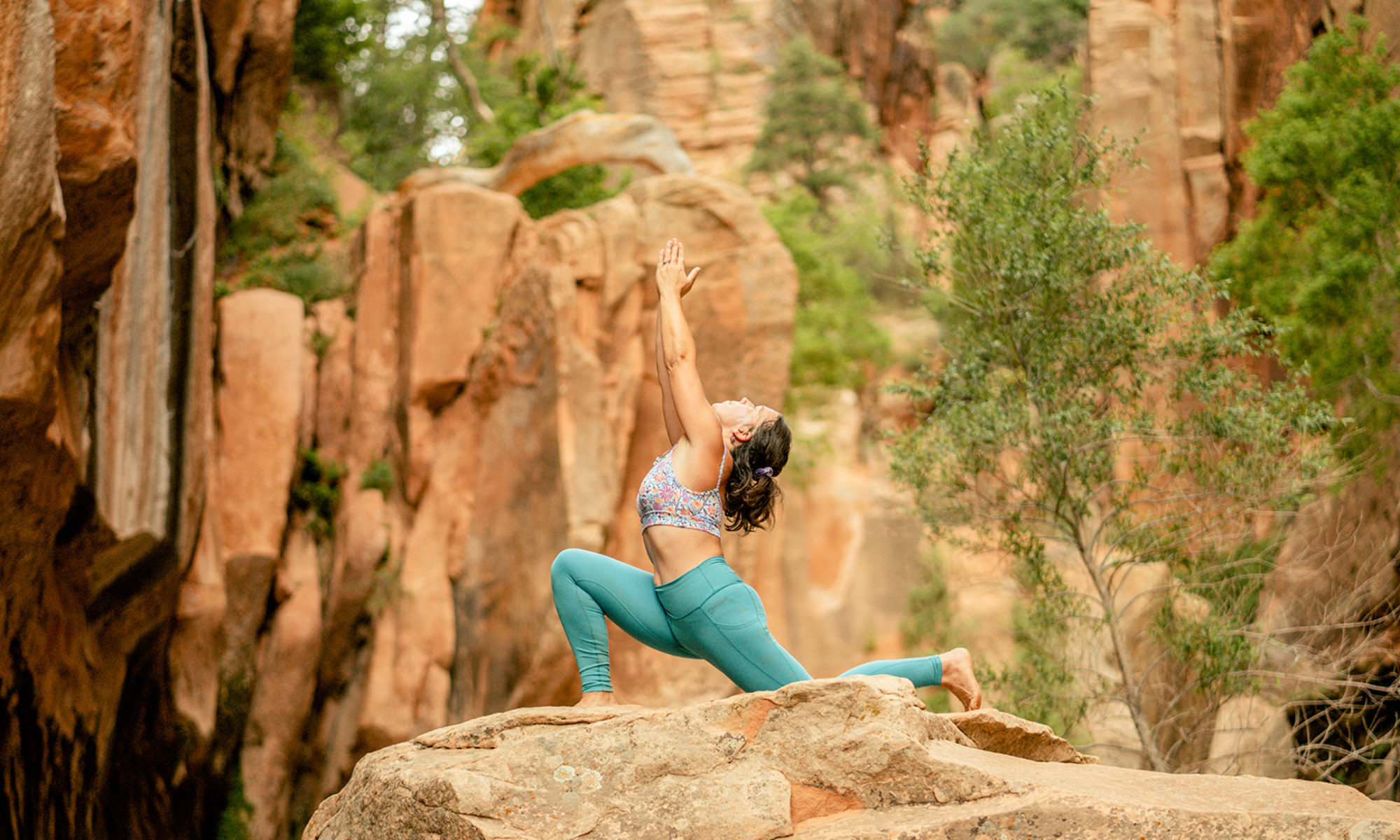
This familiar sequence of movements linked to breath, brings the body and its systems into a steady, rhythmic experience which calms the mind and as a result, offers the practitioner a gateway into the deeper benefits of yoga.
The origins of Sūryanamaskāra A are debatable. Some attribute the linked movements to 5,000 year old aesthetic practices (although their is no reliable historical evidence that modern postural yoga is that old), while others credit the movements to teachers of the Common Era. Either way, this practice is a powerful foundation of most vinyāsa classes taught in the Modern Age of yoga.
Practice Tip: When beginning a practice of sūryanamaskāra try completing one round with the following breath pattern:
* Inhale – reach the arms overhead, press the palms together
*Exhale – fold forward, soften the knees and let the belly rest on the thighs, release your head.
*Inhale – lift your chest with hands on the shins or floor (feel your ribs lift away from your hips)
*Exhale – plant your hands, step to the back of your mat and lower down to the belly
*Inhale – lift your chest and slide your shoulders back and down (away from the ears)
*Exhale – lift your hips up and back so your body is in the shape of an upside-down V (adjust distance between hands and feet as your body deserves, bend the knees if it feels good)
*Breathe five times
*Inhale – walk the feet to the hands, with the feet together, lift your chest as you did previously (ribs away from the hips)
*Exhale – fold forward, with soft knees, release your belly to the thighs and let your head hang freely
*Inhale – press the feet firmly to the mat and rise up to standing, lift the arms overhead and press your palms together
*Exhale – reset
There’s a reason why this sequence is so well known and so well practiced. These movements are simple. And yet, they are also challenging, organizing, intentional and comprehensive when executed with breath and mindfulness. The repetitive nature of the movements calms the nervous system while building muscular strength. These movements also increase functional range of motion by inspiring practitioners to find awareness and presence in normal folding and reaching functional movements.

Practice Tip: Once you’re comfortable executing sūryanamaskāra A five consecutive times, you might want to trysūryanamaskāra B. When beginning this practice, first try completing one round with the following breath pattern:
* Inhale – bend the knees, reach the arms overhead, press the palms together
*Exhale – fold forward, soften the knees and let the belly rest on the thighs, release your head.
*Inhale – lift your chest with hands on the shins or floor (feel your ribs lift away from your hips)
*Exhale – plant your hands, step to the back of your mat and lower down to the belly
*Inhale – lift your chest and slide your shoulders back and down (away from the ears)
*Exhale – lift your hips up and back so your body is in the shape of an upside-down V (adjust distance between hands and feet as your body deserves, bend the knees if it feels good)
*Inhale – step your right foot to your hands, spiral the back heel down, keep your knee bent and lift your arms overhead bringing the palms together
*Exhale – plant your hands on either side of the front foot, step the right foot to the back of your mat and lower down to the belly
*Inhale – lift your chest and slide your shoulders back and down (away from the ears)
*Exhale – lift your hips up and back so your body is in the shape of an upside-down V (adjust distance between hands and feet as your body deserves, bend the knees if it feels good)
*Inhale – step your left foot to your hands, spiral the back heel down, keep your knee bent and lift your arms overhead bringing the palms together
*Exhale – plant your hands on either side of the front foot, step the left foot to the back of your mat and lower down to the belly
*Inhale – lift your chest and slide your shoulders back and down (away from the ears)
*Exhale – lift your hips up and back so your body is in the shape of an upside-down V (adjust distance between hands and feet as your body deserves, bend the knees if it feels good)
*Breath five times
*Inhale – walk the feet to the hands, with the feet together, lift your chest as you did previously (ribs away from the hips)
*Exhale – fold forward, with soft knees, release your belly to the thighs and let your head hang freely
*Inhale – press the feet firmly to the mat, bend the knees and lift the chest upright, arms overhead, press your palms together
*Exhale – reset
* About Jessica

You Might Also Enjoy:
- Lessons From Encountering Obstacles
- Uḍḍīyana bandha: What it is and how to Use it
- Mūla What?! Insights into mūla bandha
- Ashtanga, Pregnancy and That First Year
- Truth Matters
- Always Looking, Never Seeing
- Returning to the Mat
- Yoga Doesn’t Really Mean Union
- Three Gifts
- What Does It Really Mean To Practice Non-Attachment
- Ashtanga Opening Mantra
- Yoga To Sleep Better At Night
- Some Truth About Ashtanga Yoga
- Yoga Brings Out The Worst In Me
- Catvāri cringe
- Into The Shadows – the elusive search for happiness in Ashtanga Yoga
- …and in all earnestness
- Ashtanga Yoga and the Ego
- Guru Gratitude
- 5 Ways to Find Joy, Even When You’ve Got The Grumps
- The Grateful Game
- Yoga And The Quest To Know It All
- Standing Up From Backbending – How I Overcame My Fears
- Keeping Guruji With You When You Practice
- The Heart of Ashtanga Yoga: The Tristhana Method
- Ashtanga Yoga is a Breath Practice. Seriously, It REALLY Is
- The Seven Words that Changed My Practice
